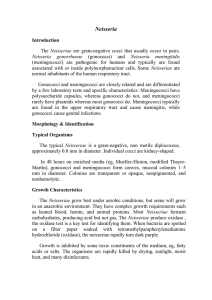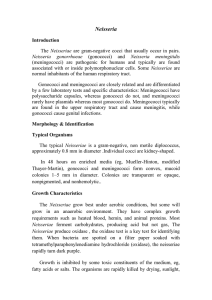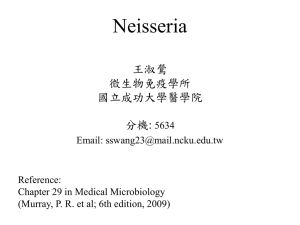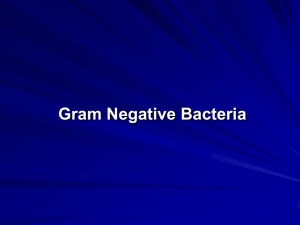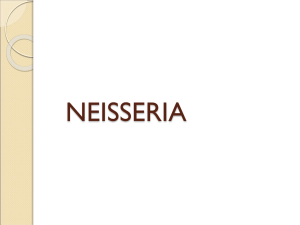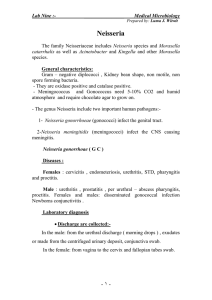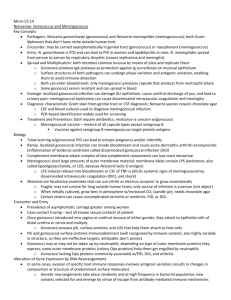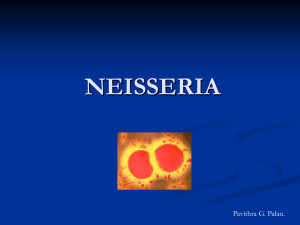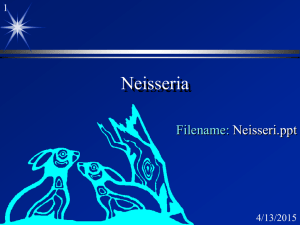Niesseria
advertisement
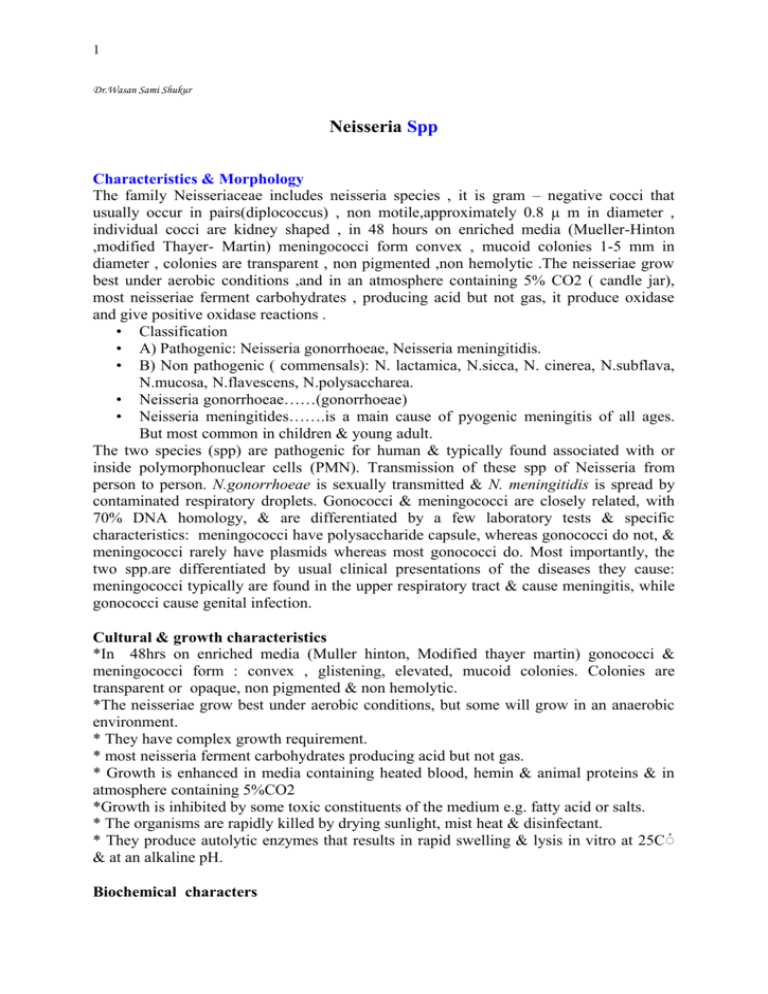
1 Dr.Wasan Sami Shukur Neisseria Spp Characteristics & Morphology The family Neisseriaceae includes neisseria species , it is gram – negative cocci that usually occur in pairs(diplococcus) , non motile,approximately 0.8 μ m in diameter , individual cocci are kidney shaped , in 48 hours on enriched media (Mueller-Hinton ,modified Thayer- Martin) meningococci form convex , mucoid colonies 1-5 mm in diameter , colonies are transparent , non pigmented ,non hemolytic .The neisseriae grow best under aerobic conditions ,and in an atmosphere containing 5% CO2 ( candle jar), most neisseriae ferment carbohydrates , producing acid but not gas, it produce oxidase and give positive oxidase reactions . • Classification • A) Pathogenic: Neisseria gonorrhoeae, Neisseria meningitidis. • B) Non pathogenic ( commensals): N. lactamica, N.sicca, N. cinerea, N.subflava, N.mucosa, N.flavescens, N.polysaccharea. • Neisseria gonorrhoeae……(gonorrhoeae) • Neisseria meningitides…….is a main cause of pyogenic meningitis of all ages. But most common in children & young adult. The two species (spp) are pathogenic for human & typically found associated with or inside polymorphonuclear cells (PMN). Transmission of these spp of Neisseria from person to person. N.gonorrhoeae is sexually transmitted & N. meningitidis is spread by contaminated respiratory droplets. Gonococci & meningococci are closely related, with 70% DNA homology, & are differentiated by a few laboratory tests & specific characteristics: meningococci have polysaccharide capsule, whereas gonococci do not, & meningococci rarely have plasmids whereas most gonococci do. Most importantly, the two spp.are differentiated by usual clinical presentations of the diseases they cause: meningococci typically are found in the upper respiratory tract & cause meningitis, while gonococci cause genital infection. Cultural & growth characteristics *In 48hrs on enriched media (Muller hinton, Modified thayer martin) gonococci & meningococci form : convex , glistening, elevated, mucoid colonies. Colonies are transparent or opaque, non pigmented & non hemolytic. *The neisseriae grow best under aerobic conditions, but some will grow in an anaerobic environment. * They have complex growth requirement. * most neisseria ferment carbohydrates producing acid but not gas. * Growth is enhanced in media containing heated blood, hemin & animal proteins & in atmosphere containing 5%CO2 *Growth is inhibited by some toxic constituents of the medium e.g. fatty acid or salts. * The organisms are rapidly killed by drying sunlight, mist heat & disinfectant. * They produce autolytic enzymes that results in rapid swelling & lysis in vitro at 25Cْ & at an alkaline pH. Biochemical characters 2 1) Fermentation of carbohydrates (Table -1): Spp Glucose Maltose. lactose sucrose Dnase N.Gonorroheae. + - - - - N. meniingitis. + + - - - N.lactiamica + + + - - N sicca + + - + - N subflava + + - _/+ - N.mucosa + + - + - N.flavescens _ - - - - N.cinerea _ - - - - 2) Oxidase reaction: Both pathogenic spp. produce oxidase enzyme which give +ve oxidase reaction. Not only the pathogenic spp are oxidase +ve, all members of this genus (Neisseria) are oxidase +ve causing oxidation of certain dyes (Tetramethyl-P-phenylene-diamine hydrochloride). When bacteria are spotted on a filter paper soaked with TMPD (oxidase ), The Neisseria rapidly turn to dark purple. 3-The production of autolytic enzymes causes lysis of these cells. His is a biochemical character (autolysins). N.gonorrhoeae * Gonococci ferment only glucose & differ antigenically from other neisseriae * Gonococci usually produce smaller colonies than those of other neisseriae. * Gonococci isolated from clinical specimens or maintained by selective subculture have typically small colonies containing piliated bacteria. *On non selective subculture, larger colonies containing non piliated bacteria also formed. *Opaque & transparent variants of both the small & large colonies also occur: The opaque colonies are associated with the presence of a surface exposed protein (opa). Antigenic structure of N.gonorrhoeae N.gonorrhoeae is antigenically heterogenous & capable of changing its surface structures invitro & invivo to avoid host defenses. Surface structures are included in Table -2. Pathogensis 3 • The gonococci attack the mucous membrane of the genitourinary tract, eye, rectum & throat producing acute suppuration that may lead to tissue invasion. This is followed by chronic inflammation & fibrosis. • In male: there are usually urithritis with yellow 'creamy' pus & painful urination. The process may extend to the epididymis. As the suppuration subsides in untreated infection, fibrosis occurs & sometimes lead to urethral stricture & sterility, urethral infection in males can be asymptomatic. In females: The primary infection is in the endocervix & extends to the urethra & vagina, giving rise to mucopurulent discharge. It may then progress to the uterine tubes causing salpingitis, fibrosis& obliteration of the tubes. Infertility occurs in 20% of women with gonogoccal salpingitis. Chronic gonococcal cervicitis or proctitis is often asymptomatic. • Extragenital infection (disseminated infection) *Gonococcal bacteremia leads to skin lesions on the hands, forearms, feet & legs. * and to tenosynovitis & suppurative arthritis. * Gonococcal endocarditis is uncommon but sever infection. Some times cause meningitis in adult similar to meningococci. *Gonococcal ophthalmia neonatorum, an infection of the eye of newborn infant, is acquired during the passage through an infected birth canal. The initial conjunctivitis rapidly progress, & if untreated it may result in blindness. Lab.diagnosis 1-Specimens: *Pus & secretions are take from urethra, cervix, rectum, conjunctiva, throat, or synovial fluid for culture & smear *Blood culture is necessary in systemic illness. 2-Smear: -Gram stained smear of urethral or endocervical exudates reveal many diplococci within pus cells, & extracellularly. -Stained smears of conjunctival exudates can be diagnostic -Culture: Immediately pus or mucous streaked on enriched selective media (ModifiedThayer martin medium) & incubated in an atmosphere containing 5% CO2 at 37Cْ. -Transport culture medium may be used if immediate incubation is not possible. -48hr after culture, the organisms can be quickly identified by their appearance on a Gram stained smear, by oxidase+ve, &by coagglutination, immunofluorescence staining, or other laboratory tests. The spp of subcultured bacteria may be determined by fermentation reactions. Traetment Recommended therapy includes ceftriaxone or ciprofloxacin 4 N. meningitidis Antigenic structure 1)Capsular polysaccharide antigens: At least (13) serogroups of meningococci have been identified by immunologic specificity of capsular polysaccharides .The most important serogroups associated with disease in humans are (A, B,C,Y and W-135). Group C & A are associated with epidemic disease. Meningococcal antigens are found in blood and cerebrospinal fluid of patients with active disease. 2) Outer membrane proteins antigens: have divided into classes on the basis of MW, all strains have either class I, class II, or class III proteins. They are responsible for the serotype specificity. Twenty serotypes have been defined. Serotypes 2&15 are associated with epidemics. 3)Meningococci : are piliated, but unlike gonococci, they do not form distinctive colony types indicating piliated bacteria. 4) Meningococcal LPS: is responsible for many of the toxic effects found in meningococcal infections. Pathogensis & clinical findings -The nasopharynx is the portal of entery -There, the org attaches to the epithelial cells with the aid of the pilli -They may form apart of the transient flora with out producing symptoms -From the nasopharynx, the org may reach the blood stream producing bacteremia -Meningitis is the most common complication of bacteremia -It usually begins suddenly with intense headache, vomiting, & stiff neck, & progresses to coma within few hours. -The meninges are acutely inflamed, with thrombosis of blood vessels & exudation of PMN leukocytes so that the surface of the brain is covered with a thick purulent exudates. During meningococcemia, there is thrombosis of many small blood vessels in many organs, with perivascular infiltration & petechial hemorrhages. Meningococcemia is favored by : 1) The absence of bactericidal IgM & IgG antibodies 2) Inhibition of serum bactericidal action by blocking IgA antibody 3) Complement deficiency (C5, C6, C7, C8) meningococci are readiy phagocytosed in the presence of a specific opsonin. Diagnostic laboratory tests 1. Specimens Blood are taken for culture , and spinal fluid are taken for smear-culture-and chemical determination. Nasopharyngeal swab cultures are suitable for carrier surveys 2. Smears Gram stained smears of the sediment of centrifuged spinal fluid show typical neisseriae within polymorphonuclear leukocytes . 5 3. Culture Cerebrospinal fluid specimens are plated on heated blood agar (chocolate agar) and incubated at 37C in an atmosphere of 5% CO2 (candle jar) . A modified Thayer –Martin medium with antibiotics ( vancomycin, colistin , amphotericin ) can use to growth of neisseriae that inhibits many other bacteria and is used for nasopharyngeal cultures . 4. Biochemical tests Spinal fluid and blood generally yield pure cultures that can be further identified by carbohydrate fermentation reactions Biochemical reactions of the Neisseriae meningitides Glucose Maltose + + Lactose Sucrose or Fructose _ _ DNase _ Or Api NH ( for Neisseriae & Haemophilus ) 5- Serological test Spinal fluid and blood generally yield pure cultures that can be further identified by agglutination with type specific or polyvalent serum .Antibodies to meningococcal polysaccharides can be measured by latex agglutination or hemagglutination tests . Treatment Penicillin G is the drug of choice for treating meningococcal disease . either Chloramphenicol or a third generation cephalosporin such as cefotaxime or ceftriaxone is used in person allergic to penicillins . Other Neisseria The other Neisseria Spp. are not considered pathogens& are often referred to as the saprophyte Neisseriae. Although they are most commonly encountered as contaminants in clinical specimens, they can occasionally be involved in bacteremia & endocarditis
